|
"TRANSFORMATION IN PROGRESS, POWER INCREASE IMMINENT!" |

Dragon Ball Kai logo
Dragon Ball Z Kai, known in Japan as Dragon Ball Kai (ドラゴンボール改「カイ」, Doragon Boru Kai; lit. "Dragon Ball Revised"), is an anime series that is a high-definition remastered and recut of Dragon Ball Z, done for its 20th Anniversary. It premiered on Fuji TV on April 5, 2009 at 9:00am just before One Piece and ended on August 25, 2011 with 98 episodes, and the two shows are being marketed together as "Dream 9", which refers to the hour in which they both air. The series average rating was 9.4%, with its maximum being 12.3% (Episode 47) and its minimum being 6.4% (Episode 18). Dragon Ball Kai returned to Japanese TV on April 6, 2014, with the Majin Buu Saga.[1]
Overview
The "Kai" (改「かい」) in the series' name means "updated," "modified," or "altered."[2] Two issues of Shonen JUMP have included some primary information about the series.[3] Interestingly, despite the series being only a director's cut of Dragon Ball Z, the Z has been completely removed from the title (at least in the Japanese version).
FUNimation Dragon Ball Z Kai logo
FUNimation Entertainment has been dubbing Dragon Ball Kai into English for a North American release, under the release title of Dragon Ball Z Kai (more information can be viewed below). On April 26, 2010, 4Kids Entertainment announced the series has currently aired on The CW's Toonzai block in its 2010-2011 season.[4] The show has also been airing premieres on the Nicktoons since May 24, 2010, and ended on January 1, 2012.[5] This is quite a change, as all the Dragon Ball series have almost always appeared on Cartoon Network in the United States. It was shown on Kix in the UK.

Dragon Ball Kai Buu Saga
After episode 97, there were initially no plans for Dragon Ball Kai to reach the Majin Buu Saga. A new anime series based on the Toriko manga debuted in April 2011, taking over the Dragon Ball Kai time slot at 9 AM on Sunday mornings before the One Piece anime series. The 97th episode of the series was broadcast on March 27, 2011 in Japan, and January 1, 2012 in America. The series was in syndication in Japan for exactly two years. Despite this, the series has been one of the top 10 rated anime series every week since syndication began in April 2009. The 98th episode of the series, which recapped the entire series and provided some closure, was released on DVD in Japan.[6][7] In November 2012, it was confirmed that production of Dragon Ball Z Kai will continue and air outside of Japan.[8] Mayumi Tanaka (the Japanese voice of Krillin in the series) posted news on her blog confirming that Dragon Ball Kai will be continuing, as voice work was already under way for the early stages of the Majin Buu story arc. Her post goes on to specify that the series revival is for the overseas market, and as of the time of her post there are no plans to air the new episodes in Dragon Ball's home country of Japan.[8] In April 2013, Sean Schemmel and Kyle Hebert (the FUNimation dub voice actors for Goku and Gohan) confirmed they were recording their lines for the FUNimation dub of the Buu Saga. In November 2013, when questioned about it on their Facebook page, it was stated by Australian anime distributor Madman Entertainment that the Buu Saga of Dragon Ball Z Kai should be released on November, 8 2014 on cartoon network, as they are just waiting on dubs to be finished.[9]
Dragon Ball Kai returned with the Majin Buu arc to Japanese TV on April 6, 2014, taking over the time slot previously occupied by Toriko.[1] This story arc is comprised of 69 episodes, raising the total episode count for the entire series to 167 episodes.
Series information

Comparison of aspect ratios from Dragon Ball Z Kai (left) and Dragon Ball Z (right). Click to enlarge
The series is being extensively "refreshed" for Japanese television. This is not a new animation, but rather a remastered edit that runs through certain events of Dragon Ball Z. Part of this is reformatting and extending the picture to 16:9 Widescreen. Through digital processing, the image is made vibrant. All the music, damage and noise remaining on the Dragon Ball Z film is removed, making the image much clearer in high-definition.
A comparison with the original video side-by-side shows considerable cropping to achieve the 16:9 aspect ratio. However, it seems carefully done to avoid missing anything important. The original image is not stretched, just cut where it would be more appropriate, being a "tilt and scan" or "reverse pan and scan" of the original Dragon Ball Z footage.

New ending credits with new animations of Dodoria and Zarbon (top left), the Ginyu Force (top right), Frieza (center left), Raditz (center right), and Nappa and Vegeta (bottom left)
Dragon Ball Kai includes a complete re-recording of the dialog by most of the original Japanese voice cast, as well as completely new sound design with updated sound effects. The opening and ending themes are completely new. Takayoshi Tanimoto performs the series' opening themes "Dragon Soul" and "Kuu-Zen-Zetsu-Go", and the closing theme "Yeah! Break! Care! Break!" This new opening and closing credits have newly animated appearances by most of the main cast, as well as for the villains, such as Raditz, Nappa, Vegeta, Frieza, Zarbon, Dodoria, and the Ginyu Force. There's also a new artwork clip after every intermission, such as one of Cui and Vegeta in episode 19. Unlike the original Dragon Ball Z, which only had two sets of eye-catches for the entire series, in Dragon Ball Kai, it changes every few episodes to feature an appropriate character ensemble/situation.
The Garlic Jr. Saga does not air in Dragon Ball Kai. Originally lasting from episodes 108 to 117, the saga featured the return of Garlic Jr., the main villain from the first DBZ movie. The saga was completely filler and Garlic Jr. or any of his henchmen did not appear in the original manga. Because Kai stays truer to the manga, this saga has been completely cut out.
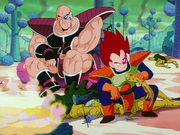
Original palette
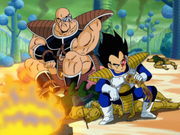
Revised palette
Among other things, Vegeta's unique palette while on an unnamed planet in the beginning of the series has been altered, however, Nappa's armor is still different from the armor he wears on Earth. Piccolo's blood in the Raditz fight has also been recolored to purple (in DB and in this fight in DBZ, Piccolo was drawn with red blood, but purple blood in the rest of the DBZ series). However, when Raditz is explaining to Goku about the Saiyans, Vegeta has his original palette.
Confirmed episodes of Dragon Ball Kai to have new animation inserted include: 16, 21, 22, and 24 through 54. Episode 16 is the first episode in the series that includes several instances of completely new animation spliced in with the original. More than likely, this was done to bridge gaps left behind when filler material was removed, so as to keep the length and pace of the episode intact. It is also possible that this was done to replace damaged frames. This is seen again in episode 21 at time indexes 14:25 through 14:50 and again numerous times, interlaced with the original animation, starting at 18:44 and lasting until 21:44 (the end of the episode). The style of the animation should be considered "neo-classic" for it is designed to blend in seamlessly with the existing animation.
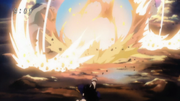
New scene: Vegeta's assault
For the Androids Saga, the animation in the opening scene and closing credits has been altered a bit to fit the current storyline. New animations of Dr. Gero, Android 19, Android 17, Android 18, Android 16, and Cell appear, as well as the Super Saiyan appearances of Goku, Vegeta, Future Trunks, and Gohan. The new intro also showcases battles taking place within the saga, such as Vegeta vs. #18, Piccolo vs. #17, #16 vs. Cell, Goku vs. Cell, and ends showing a sequence of the Z Fighters standing together with their Cell Saga appearances. The ending credits are also different, showcasing Goku flying with Shenron as the faces of the main cast appear. He proceeds to transform into a Super Saiyan and the cast joins him in flight. The sequences ends with the Z Fighters standing in front of the Earth, with Shenron and Porunga in the backdrop.
Toei released the first set on DVD and Blu-ray in September, 2009 in 4:3 aspect ratio, which is said that is how it was originally created and was only 16:9 ratio before because it was cropped for HD TV.[citation needed] The refreshed series also spawned a stage play named Dragon Ball Kai: Super Battle Stage.
Music
Dragon Ball Kai used a new background musical score by Kenji Yamamoto, composer of the Dragon Ball video games. His score was used regularly for all releases of episodes 1-95, however, he was given a layoff notice from Toei Animation after it was discovered that he was infringing his music off of other artists and eventually resigned. The last few episodes of Dragon Ball Kai, as well as Japanese reruns of past episodes, made use of music recycled from Dragon Ball Z by Shunsuke Kikuchi (although the Dragon Ball Kai theme songs remained intact), however, the placing of the music differed from the original series. It is unconfirmed if the original matching of the tracks with the scenes as the original series will ever be released.
The American broadcast of Dragon Ball Z Kai was affected as well. The 5th American DVD/Blu-ray volume was delayed twice, due to FUNimation replacing Yamamoto's score with the original Dragon Ball Z background score for the remainder of the English release of Dragon Ball Z Kai, for the DVDs/Blu-rays (all episodes) and the TV Version (all episodes). The Dragon Ball Kai collection including episodes 1-26 has included the random placement of the original tracks but does not have the original scores as they were initially created for the series. It is unclear whether a version will be released with properly synced music pertaining to Shunsuke Kikuchi's original tracks.
FUNimation
"The phenomenon that defined a generation... is back for more." |
Navarre revealed during its Q3 2010 earnings conference call, on February 2, 2010, that its North American anime distributor FUNimation had licensed the Dragon Ball Kai series for release in the "latter part of the upcoming fiscal year." However, it was re-titled Dragon Ball Z Kai. FUNimation later confirmed the license with AnimeNewsNetwork.com. Dragon Ball Z Kai Part one was released on May 18, 2010. The cast for Dragon Ball Z Kai was mostly the same as Z except for a few re-casts for various reasons. The English dub for the series is produced by Okatron 5000 in Dallas, TX, US at the same recording studio used for the video games of the Dragon Ball franchise, with Christopher Sabat as one of the primary voice directors. Cartoon Network, broadcaster of all original Dragon Ball media, passed on the rights to show Dragon Ball Z Kai. Instead, Nicktoons aired Dragon Ball Z Kai from May 24, 2010 until January 1, 2012.[5]

A comparison of the opening scene in Dragon Ball Kai. The shot on the left is the original uncut scene, and the right being the one that appeared on Nicktoons. It is clear to see all traces of blood have been removed from Bardock's face
The series is edited on Nicktoons to fit the intended audience, and occasionally contains different verbiage than the home release, which is entirely unedited. Some character attacks regain their correct and untranslated-proper-noun announcements in the unedited dub (i.e. "Makankōsappō" instead of Special Beam Cannon, "Kienzan" instead of Destructo Disk, etc.), although some of the official English names for the attacks are retained for the broadcast version. Most other names used in the English dub remain the same (i.e. Krillin and Tien Shinhan instead of "Kuririn" and "Tenshinhan"). Less liberty is taken with the script, and episode titles are mostly literal translations of their original Japanese versions. Nicktoons' broadcast originally used Kenji Yamamoto's musical score, however it changed to Shunsuke Kikkuichi's cues after the music plagiarism incident (see "Music" above). The opening theme was retained, although shortened to allow time for more commercials. The broadcast uses Vic Mignogna's version of the theme song for the full run, even though his complete version was only used for Episodes 27 - 39 on the official home video release. The ending theme is usually cut, and the credits are shown in split screen, although a shorter version of the ending has been used on occasion.
The Toonzai kids block on The CW also broadcasts FUNimation's English dub of Dragon Ball Z Kai. Their broadcast contains most of the edits of the Nicktoons version, as well as extra editing to fit the stricter broadcast standards. The broadcast has been notorious for it's questionable editing practices such as erasing Shenron from the opening credits in some episodes, colorizing Mr. Popo blue, changing halos into shining spheres, adding sparkles to Chiaotzu's fatal explosion, drawing an eye over Gohan's swollen face, and replacing dialogue considered objectionable with sound-a-like voices. Like the Nicktoons' broadcast, the Toonzai broadcast featured the Kenji Yamamoto score before being replaced with the Shunsuke Kikuchi score. Aside from the Shenron edit, the opening and closing also remain the same as the Nicktoons broadcast.
Edited episodes are also available for streaming in the United States on both Nicktoons' and Toonzai's respective websites.
Recasts
Episodes
Main article: List of Dragon Ball Z Kai episodes

Super Saiyan Goku
Toei Animation stated that the Dragon Ball Kai episodes would be edited to more closely follow Akira Toriyama's original story in the manga, resulting in a faster moving story, and to remove any damaged frames.[10] Dragon Ball Kai minimizes the filler material produced for Dragon Ball Z's original production run. On the broadcast episodes, only a few minutes of filler material with no impact to the story have been left in (like Gregory's appearance at King Kai's planet, who wasn't present in the manga), probably to help the episode reach its full 20 min.
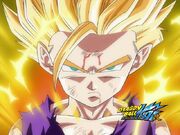
Super Saiyan 2 Gohan
Happinet (the Japanese company releasing the series on DVD and Blu-ray) announced the Japanese DVD and Blu-ray release would have an end point of "99 Episodes (tentative)" meaning the current planned and announced episode count will end at 99.[11] Actually, Dragon Ball Kai was supposed to last for 99 episodes, but everything had originally been thrown off an entire week due to the horrific tsunami that struck Japan the prior week. The series temporarily ended with 98 episodes on August 25, 2011, and returned with 69 Majin Buu Saga episodes on April 6, 2014.[1]
English adaptations

Dragon Ball Z Kai, "The Final Chapters" logo
The title screen translations are far more similar this time around, but are changed to fit properly into English. Edits have been made to the version appearing on Nicktoons, these include the removal of blood (which sometimes is replaced with black grayish liquid where the blood is supposed to be), overly violent moments, profanity, and others. The CW's Toonzai airings, however, are edited even more so than the Nicktoons version, due to tighter restrictions on broadcast programming. These edits include recoloring Mr. Popo's skin from black to blue, replacing dead characters' halos with glowing orbs, removing virtually all references to death in both dialogue and episode titles and renaming certain special techniques (i.e. Goku's Spirit Bomb renamed as the "Spirit Blast" and Vegeta's Galick Gun as the "Galick Blast"). Also in the beginning of the intro song, Toonzai has edited out Shenron and replaced him with a green colored sky. On Nicktoons, the series ended on January 1, 2012.
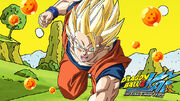
Dragon Ball Z Kai, "The Final Chapters" (Majin Buu arc in Europe)
The series returned with the 69 Majin Buu Saga episodes in 2014 in Europe, carrying the sub-title "The Final Chapters". This remastered and reedited series was broadcasted in the UK on Kix, in Portugal on Sic Radical, in Poland on AXN Spin, and in France on Game One. On May 25, 2014, FUNimation and Adult Swim announced that the English dub Dragon Ball Z Kai will air uncut on Adult Swim's Toonami block starting in fall 2014.[12] The show began airing at 12:00 AM on November 8, 2014, replacing Bleach.
DVD/Blu-Ray
All the Japanese and FUNimation DVD and Blu-ray releases are presented in an original 4:3 aspect ratio, although there is an option to zoom the picture to a 16:9 aspect ratio using the television remote to make it appear identical to the original Japanese broadcast.
The uncut box set entitled Dragon Ball Z Kai Part One was released on the 18th of May 2010,[13] and Part Two was released on the 14th of September, 2010.[14]
| Title | Release | Episode | Region Compatibility* | Details |
|---|---|---|---|---|
| Dragon Ball Z Kai Part One | May 18, 2010 | 1 - 13 | Blu-ray A/B DVD 1/4 |
Run-time of 325 minutes, TV-PG Rating, available on DVD & Blu-ray |
| Dragon Ball Z Kai Part Two | September 14, 2010 | 14 - 26 | Blu-ray A/B DVD 1/4 |
Run-time of 325 minutes, TV-PG Rating, available on DVD & Blu-ray |
| Dragon Ball Z Kai Part Three | December 14, 2010 | 27 - 39 | Blu-ray A/B DVD 1/4 |
Run-time of 325 minutes, TV-PG Rating, available on DVD & Blu-ray |
| Dragon Ball Z Kai Part Four | March 8, 2011 | 40 - 52 | Blu-ray A/B DVD 1/4 |
Run-time of 325 minutes, TV-PG Rating, available on DVD & Blu-ray |
| Dragon Ball Z Kai Part Five | June 28, 2011 | 53 - 65 | Blu-ray A/B DVD 1/4 |
Run-time of 325 minutes, TV-PG Rating, available on DVD & Blu-ray |
| Dragon Ball Z Kai Part Six | September 13, 2011 | 66 - 77 | Blu-ray A/B DVD 1/4 |
Run-time of 290 minutes, TV-PG Rating, available on DVD & Blu-ray |
| Dragon Ball Z Kai Part Seven | March 20, 2012 | 78 - 88 | Blu-ray A/B DVD 1/4 |
Run-time of 275 minutes, TV-PG Rating, available on DVD & Blu-ray |
| Dragon Ball Z Kai Part Eight | June 5, 2012 | 89 - 98 | Blu-ray A/B DVD 1/4 |
Run-time of 250 minutes, TV-PG Rating, available on DVD & Blu-ray |
| Dragon Ball Z Kai Season One | May 22, 2012 | 1 - 26 | Blu-ray A/B DVD 1/4 |
Run-time of 625 minutes, TV-PG Rating, available on DVD & Blu-ray |
| Dragon Ball Z Kai Season Two | May 22, 2012 | 27 - 52 | Blu-ray A/B DVD 1/4 |
Run-time of 625 minutes, TV-PG Rating, available on DVD & Blu-ray |
| Dragon Ball Z Kai Season Three | September 11, 2012 | 53 - 77 | Blu-ray A/B DVD 1/4 |
Run-Time 625 minutes, TV-PG Rating, available on DVD & Blu-ray |
| Dragon Ball Z Kai Season Four | March 12, 2013 | 78 - 98 | Blu-ray A/B DVD 1/4 |
Run-Time 525 minutes, TV-PG Rating, available on DVD & Blu-ray |
* As stated on back of case
Staff
- Series & Episode Director: Yasuhiro Nowatari
- Assistant Episode Director: Yasunori Koyama
- Producer: Gō Wakabayashi, Kazuya Watanabe, Kohei Obara, Kyotaro Kimura, Makoto Seino
- Production Chief: Atsunori Kazama
- Planning: Kōzō Morishita, Yoko Matsusaki
- Series Composition Cooperation: Kazutaka Satoh (Caramel Mama)
- Script: Aya Matsui, Hiroshi Toda, Katsuyuki Sumisawa, Keiji Terui, Sumio Uetake, Takao Koyama, Toshiki Inoue
- Animation: Naotoshi Shida (OP & ED Staff), Tadayoshi Yamamuro (OP & ED Staff), Tatsuya Nagamine (OP & ED Staff), Yasunori Gotō (OP & ED Staff)
- Music: Kenji Yamamoto, Shunsuke Kikuchi, Norihito Sumitomo
- Sound Director: Yukio Nagasaki, Satoshi Motoyama
- Sound Effects: Hidenori Arai (Fizz Sound Creation)
- Editing: Kenta Katase, Shinichi Fukumitsu (eps 1-10)
- HD Editing: Emi Maruo, Tetsuro Tsukada
Theme songs
- Opening (OP):
- "Dragon Soul" version 1: episodes 1~29
- "Dragon Soul" version 2: episodes 30~54
- "Dragon Soul" version 3: episodes 55~68
- "Dragon Soul" version 4: episodes 69~98
- "Fight it out" (performed by Masatoshi Ono, with the musical composition by Yō Yamazaki and lyrics by Hiroshi Yamada): episode 99~onwards (international version)
- "Kuu-Zen-Zetsu-Go": episode 99~167 (Japanese version)
- Endings (ED):
- "Yeah! Break! Care! Break!: episodes 1~54
- "Wings of the Heart": episodes 55~98
- "Never give up!!!" by Junear: episode 99~onwards (international version)
- "Dear Zarathustra": episode 99~111 (Japanese version)
- "Junjō": episode 112~124 (Japanese version)
- "Oh Yeah!!!!!!!": episode 125~onwards (Japanese version)
- Insert Songs (IN):
- "Over the Star" by Saki Oshitani (ep 17)
- "Saiyan Blood" by Ryō Horikawa (ep 41)
- "Tatta Hitori no Senshi" by Takeshi Kusao (ep 82)
- "Only a Chilling Elegy" by H.E Demon (FUNimation dub)
Trivia
- In the 1st ending credits ("Yeah! Break! Care! Break!"), Launch is shown along with the rest of the cast while all the scenes from Dragon Ball Z she was in were filler that have been cut out from Kai.
- Some (but not all) of the gory moments have been edited to a degree along with nudity. In Dragon Ball Z, when Piccolo fires his Special Beam Cannon at Raditz and Goku, he creates a hole through both of them and a heavy amount of blood is shown, while in Dragon Ball Kai, no blood is seen at all, save for the holes that Piccolo creates in the centers of their bodies. More recently, in the scene where Krillin blasts a hole through Vegeta, only blood stains are seen in Kai while in Dragon Ball Z, there is blood coming out of the hole. Similarly, when Vegeta is executed by Frieza, the beam is not shown when it penetrates his chest. Nudity is notably edited as well such as in the first episode of Dragon Ball Kai, whenever Goku (as a baby) is shown, his genitals are covered up by making objects that he is sitting on appear to be covering his genitals. In a similar manner in episode 4 of Kai, Gohan's genitals are edited as well by using his tail to cover him when he is shrinking from his Great Ape state to his normal self. All these edits are made quite possibly because Japan's television broadcasting laws have become stricter since Dragon Ball Z was first aired.
- In the 48th episode, "The Angry Super Saiyan! Goku Throws Down the Gauntlet!", Goku announces in front of Frieza "I am the Super Saiyan, Son Goku!" This marks the first time in the history of the English-dubbed Dragon Ball anime series that Goku has addressed himself by his full name (in Japanese order), "Son Goku."
- Parts 1-4 of the DVD/Blu-ray releases are now out of print, as the music on them was composed by Kenji Yamamoto and was released before he was fired and before the music was switched for the season releases.
Gallery
See also
References
- ↑ 1.0 1.1 1.2 V-Jump, Issue #4, 2014
- ↑ "Dragon Ball Kai" at animenewsnetwork.com
- ↑ "Dragon Ball Z to Rerun on Japanese TV in HD in April", animenewsnetwork.com
- ↑ "Dragon Ball Z Kai to Air on TheCW4Kids on Saturdays", animenewsnetwork.com
- ↑ 5.0 5.1 "Top-Ranked Nickelodeon Announces Its 2010-11 Season Programming Slate at Annual Upfront Presentation", animenewsnetwork.com
- ↑ "Toriko Manga Gets TV Anime Series Next April (Updated)", animenewsnetwork.com
- ↑ "FUNimation's Final “Kai” Volume Coming in June", kanzenshuu.com
- ↑ 8.0 8.1 "It will not be aired in Japan, but overseas, Dragon Ball Kai is continuing. Right now, we are recording the part at the World Martial Arts Tournament, where Goten and Trunks infiltrate the adults division by one standing on the other's shoulders. The image is definitely clearer than before. We talked about how we want it to air in Japan, too." - Mayumi Tanaka's blog, November 2012
- ↑ "Australia's Madman Ent: DBZ Kai's Buu Saga Should Come in 2014"
- ↑ "Toei Confirms Dragon Ball Kai is Edited to Follow Manga", animenewsnetwork.com
- ↑ happinet-p.com
- ↑ Dragon Ball Z Kai to Run on Adult Swim's Toonami Block
- ↑ "Dragon Ball Z Kai DVD Part 1 (Hyb)", rightstuf.com
- ↑ "Dragon Ball Z Kai DVD Part 2 (Hyb)", rightstuf.com















